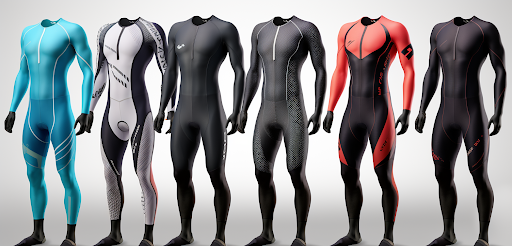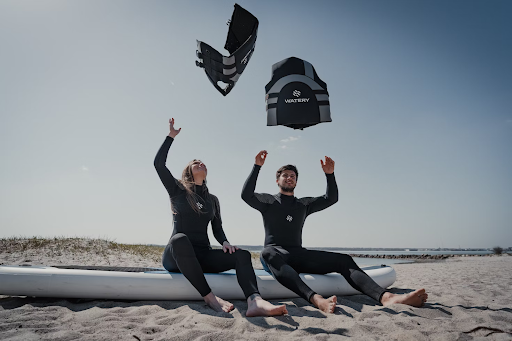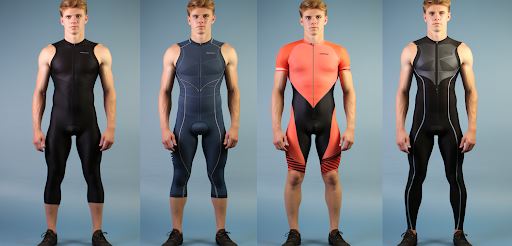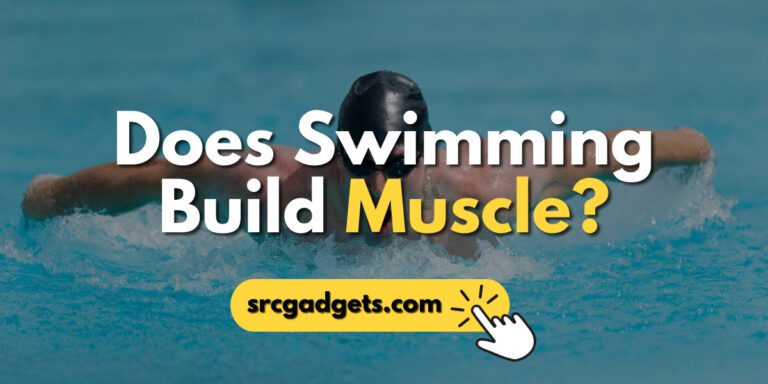What to Wear for Triathlon Swim
Have you ever wondered what to wear for a triathlon swim? If you’re like most triathletes, you probably have a lot of questions about the best clothing and gear for this challenging event. This guide covers details of what to wear for a triathlon swim and the gear considerations for the swim leg of a triathlon.
Whether you’re a seasoned triathlete or just dipping your toes into the world of multi-sport events, making the right choices for your swim attire can greatly impact your performance on race day. So, let’s dive right in!
Triathlon Swim Gear and Attire
When it comes to triathlon swim gear and attire, precision and suitability are paramount. Your choices can significantly affect your comfort, speed, and overall race experience. It’s important to train for a triathlon swim and invest in quality gear that is suited for your race distance and conditions.
Wearing the right swimsuit, goggles, and swim cap can help you stay comfortable and confident in the water. Additionally, selecting the right swim accessories can also help you maximize your performance.

Here, we’ll explore the key elements of your swim ensemble:
1. Triathlon Suits
Triathlon suits, often referred to as tri suits, are specially designed for the unique demands of the sport. They offer a streamlined fit, ensuring minimal drag in the water. Tri suits come in various styles, including one-piece and two-piece tri kits.
Types of Triathlon Suits
Triathlon suits can be categorized into two main types: full tri suits and two-piece tri kits.
a. Full Tri Suits:
These one-piece suits offer maximum coverage and streamline your body for optimal hydrodynamics. They are made of lightweight, breathable materials and are designed to provide maximum comfort and performance.
b. Two-Piece Tri Kits:
Comprising triathlon shorts and a top, two-piece kits provide flexibility and convenience during transitions. These kits are a popular choice among triathletes as they are lightweight and breathable and offer a comfortable fit. They are also ideal for racing and training, as they provide adequate support and protection.
Benefits of a Triathlon Suit
There are several benefits to wearing a tri suit, including:
1. Streamlined Design:
Tri suits are designed to reduce water resistance, helping you glide through the swim leg with ease. They are also designed to be lightweight and comfortable, so you can stay at the top of your game during the bike and run legs.
Additionally, tri suits are often made with breathable fabrics, which can help prevent overheating during physical activity.
2. Quick Transition:
Transitioning from the swim to the bike leg is smoother with a tri suit. There’s no need to change clothes, saving you valuable time. This saves you from having to change clothes in transition and saves time so you can focus on your race. Tri suits are also designed to be aerodynamic, which helps to improve your performance.
3. Improved aerodynamics:
Tri suits are designed to be aerodynamically optimized, helping you make the most of your speed during the bike and run legs. Tri-suits are designed to reduce drag and help you move more efficiently.
The fabric of the suit is designed to minimize air resistance and drag, which helps you save time and energy. Additionally, the suit is designed to be lightweight and breathable, which helps to reduce fatigue and help you stay comfortable during the race.
2. Wetsuits for Triathlons

Wetsuits play a critical role in open water triathlons, providing buoyancy and thermal protection. Wetsuits are made from neoprene, which is a type of foam that traps a layer of water against the skin. This helps to insulate the body and reduce heat loss, as well as providing buoyancy that helps swimmers stay afloat in the open water. They come in two main styles: sleeveless and full wetsuits.
Why do Wetsuits Matter?
Wetsuits offer two key benefits:
a. Buoyancy:
A wetsuit’s buoyancy helps you stay afloat, conserving energy for the bike and run legs. The wetsuit traps a layer of water between the body and the wetsuit. This layer of water provides extra resistance to the water, which helps to keep your body afloat.
b. Thermal Protection:
In cold water, a wetsuit keeps your body temperature stable, enhancing comfort and safety. It also reduces wind chill and helps to regulate your body temperature during physical activity. A wetsuit also protects you from cuts and abrasions.
Sleeveless vs. Full Wetsuits
Choosing between a sleeveless and full wetsuit depends on your preferences and race conditions. A sleeveless wetsuit offers a better range of motion and flexibility, which makes it better suited for races that involve a lot of swimming.

A full wetsuit, on the other hand, is better suited for races that involve a lot of paddling or surfing, as it offers more protection from the elements. Sleeveless wetsuits offer greater mobility, while full wetsuits provide more coverage and warmth.
Swimwear for Open Water and Pool Swims
The type of swimwear you choose depends on whether you’re participating in an open water or pool-based triathlon. Each setting comes with its own set of considerations.
a. Open Water Swims
For open-water swims, you’ll likely wear a triathlon wetsuit for buoyancy and cold-water protection. Open water swims also call for a brightly colored swim cap to help boaters and lifeguards see you in the water.
Swim goggles are also necessary so you can see clearly in the water. Finally, a tow float is required if you’re swimming long distances. Additionally, consider swim goggles to enhance visibility.
b. Pool Swims
In pool-based triathlons, your attire may differ. A competition swimsuit, often referred to as a racerback, is a suitable choice.
Focus on comfort and minimizing drag in the controlled pool environment. A cap or swim cap is also recommended to protect your hair from chlorine. You should also wear goggles to protect your eyes. Finally, don’t forget a pair of swim fins to help you swim more efficiently.
3. Swim Cap

While it might seem like a small detail, a swim cap is a vital piece of swim gear. It helps to keep the hair from clogging the swimmer’s face and ears, helps to improve hydrodynamics and can reduce drag. Swim caps are also designed to protect hair from chlorine and other pool chemicals. It serves multiple purposes.
a. Hydrodynamics:
A snug-fitting swim cap helps streamline your head in the water, reducing resistance. This will make you swim faster with less effort. A swim cap can also help protect your hair from chlorine and other chemicals used in swimming pools.
Swim caps are also a great way to add a bit of personality to your swim outfit. They come in a variety of colors, patterns, and materials, so you can easily find one that fits your style and personality.
b. Temperature Regulation:
In cold water, a cap can help retain heat and keep you comfortable. It will also help protect your head from sunburn and harmful UV rays. Plus, it can help keep your hair and ears dry, preventing you from feeling cold and uncomfortable.
c. Identification:
Swim caps are often color-coded to indicate different waves or age groups in a triathlon, making it easier for race officials to identify participants.
This helps to reduce confusion and ensure that all swimmers are in the correct lanes. Additionally, swim caps provide an important layer of protection for swimmer’s heads against chlorine and other pool chemicals.
4. Goggles

Clear vision is crucial during the swim leg. Quality swim goggles protect your eyes from water, provide clarity, and reduce the risk of discomfort or irritation. Consider anti-fog coatings and UV protection for added benefits.
a. Clothing for Comfort
Under your triathlon suit or wetsuit, opt for moisture-wicking base layers to prevent chafing and discomfort. These snug-fitting garments help manage sweat and ensure comfort throughout the race.
5. Socks and Gloves
In colder water or during particularly long swims, triathletes may choose to wear neoprene socks and gloves. These accessories offer additional thermal protection, keeping your extremities warm and functional.
6. Helmet and Other Gear (for Aquabike)
If you’re participating in an Aquabike event (a swim and bike combination), you’ll need to have your bike gear ready for the transition. Ensure your helmet, cycling shoes, and any other bike-related gear are easily accessible and properly fitted for a smooth transition from swim to bike.
Choosing the Right Swimwear for Different Conditions
Open Water Swims
For open water swims, you’ll want to focus on the following aspects:
a. Visibility:
Choose brightly colored swimwear to enhance your visibility to other swimmers and safety personnel.
b. Neoprene Accessories:
In colder water, consider neoprene swim shorts or tops for added warmth without sacrificing mobility.
C. Safety Buoy:
Some open water swimmers opt to use a safety buoy attached to their waist. These buoys provide added visibility and can double as storage for small items like energy gels.
Pool Swims
When preparing for a pool-based triathlon, the emphasis is on minimizing resistance:
Streamlined Swimsuit: Look for competition swimsuits designed to reduce drag in the water. These suits are often made of hydrophobic materials.
Swim Cap: A silicone swim cap can help streamline your head, reducing friction with the water.
Shave and Taper: Some competitive swimmers choose to shave their body hair before a race to further reduce resistance. A well-planned taper (reduced training load before the race) can also improve performance.
The Significance of Choosing the Right Gear
Speed and Efficiency
Selecting the appropriate swim gear can significantly impact your speed and efficiency in the water. Triathlon suits and wetsuits are designed with hydrodynamics in mind, reducing drag and allowing you to move through the water more swiftly. This can save you valuable seconds, which can be crucial in a competitive race.
Comfort and Endurance
Comfort plays a vital role in your swim performance. Ill-fitting or uncomfortable gear can lead to distractions and discomfort, potentially affecting your endurance. Triathlon suits, when chosen correctly, provide a snug yet comfortable fit, allowing you to focus on your swim without the distraction of shifting or chafing clothing.
Temperature Regulation
Water temperature can vary widely between different triathlon events. Wetsuits provide thermal protection in colder water, preventing hypothermia and ensuring you can complete the swim leg comfortably. In contrast, for pool swims in warmer conditions, selecting appropriate swimwear helps regulate your body temperature and avoid overheating.
Adhering to Rules and Regulations
In addition to making informed gear choices, it’s crucial to understand and adhere to the rules and regulations governing swim attire in triathlon events. Different races may have specific guidelines, but here are some common rules to keep in mind:
a. Wetsuit Thickness:
Some races have rules specifying the maximum thickness of wetsuit material allowed. Ensure your wetsuit complies with these regulations.
b. Swim Cap Color:
As mentioned earlier, swim caps are often color-coded to indicate different waves or age groups. Wearing the correct color is not only a rule but also contributes to the efficient organization of the race.
c. Drafting Rules:
In open water swims, there are often rules about drafting (swimming closely behind another competitor to reduce resistance). Familiarize yourself with these rules to avoid penalties.
d. Hydration and Nutrition Gear:
If your race allows for the use of hydration or nutrition gear during the swim, ensure it’s compliant with race rules. For instance, some races permit swim-specific hydration packs.
Maintaining the Integrity of the Sport

Adhering to rules and regulations is not just about compliance; it’s also about maintaining the integrity of the sport. Triathlon is known for its fair competition and adherence to a set of rules that apply to all participants. When every athlete follows these rules, it ensures a level playing field and upholds the spirit of fair competition.
Moreover, adhering to these rules sets a positive example for fellow triathletes, especially newcomers to the sport. It promotes sportsmanship and a sense of community among participants.
Preparing for the Swim
Practice in Your Gear
Before race day, it’s essential to practice swimming in your chosen gear. This includes your triathlon suit or wetsuit, swim cap, and goggles. Familiarity with your gear will boost your confidence and help you feel more comfortable in the water.
Open Water Training
If your triathlon includes an open water swim, try to incorporate open water training sessions into your preparation. Open water conditions can be quite different from the pool, so getting accustomed to waves, currents, and sighting (navigation) is crucial.
Race-Specific Gear Check
A day or two before your triathlon, conduct a thorough gear check. Ensure your triathlon suit or wetsuit is in good condition, your swim cap and goggles fit properly, and any other gear you plan to use is ready to go. This eliminates last-minute surprises and allows you to make necessary adjustments.
The Swim-to-Bike Transition
Transitioning from the swim to the bike leg smoothly is a skill that can save you precious time. Here are some tips to master this transition:
Practice Transitions
Set up a mock transition area during your training sessions. Practice getting out of your swim gear and into your cycling gear quickly. This includes removing your wetsuit (if applicable), putting on your helmet, sunglasses, and cycling shoes, and grabbing your bike.
Layout and Organization
When you arrive at the race, take time to lay out your transition area strategically. Lay out your gear in the order you’ll need it. This minimizes the chances of fumbling around and wasting time during the transition.
Know the Route
Familiarize yourself with the swim exit and the route to the transition area. Having a mental map of where you’re going can help you navigate the transition with confidence.
Body Marking
Before the race, race officials will often mark your body with your race number. Make sure it’s easily visible and not covered by your wetsuit. This helps race organizers and fellow competitors identify you.
Post-Swim Nutrition
Consider placing some quick, easily digestible nutrition in your transition area for after the swim. Energy gels or bars can help kickstart your energy levels as you head out on the bike.
Conclusion
In conclusion, choosing the right swim gear and attire is only part of the equation for a successful triathlon swim. Preparation, practice, and efficient transitions are equally crucial. By following these tips and being mindful of the gear and attire guidelines we’ve discussed in this guide, you’ll be well-equipped for a fantastic swim leg and a smooth transition to the bike leg on race day.
We hope this guide has been informative and helpful as you prepare for your next triathlon. Remember that triathlon is not just about competition; it’s also about camaraderie and personal achievement. So dive in, give it your all, and enjoy the journey!






